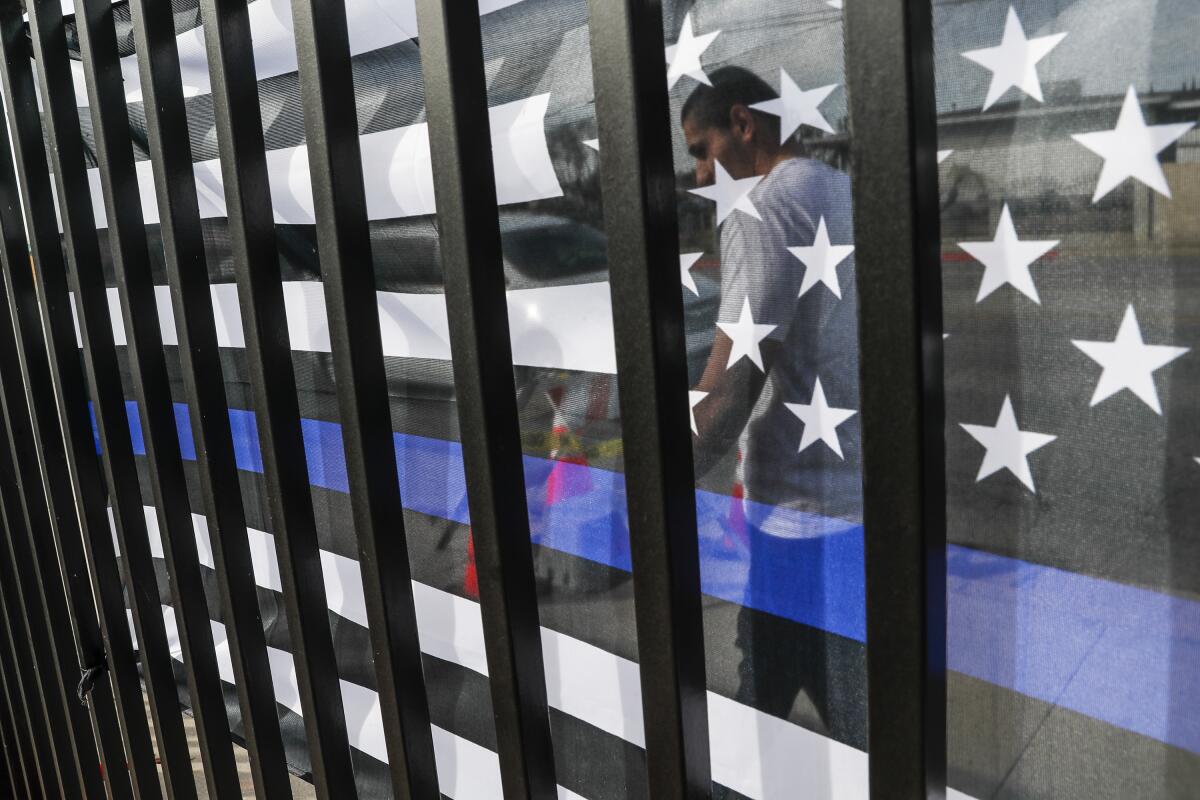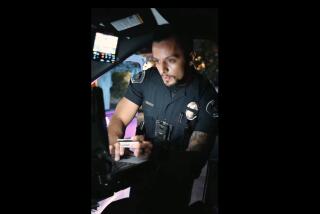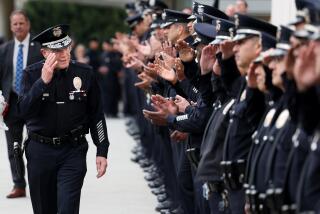LAPD ban of ‘thin blue line’ flags is latest salvo in culture war

For some, the “thin blue line” flag is an expression of solidarity with police officers who have lost their lives on the job.
To others, the black-and-white American flag with a single blue stripe is a potent symbol of the ties between right-wing extremism and American law enforcement.
The tension between those irreconcilable interpretations spilled over in the Los Angeles Police Department this month, when Chief Michel Moore ordered the flag, which was widely displayed in station lobbies around the city, to be removed from public view.
Along with banning the flag from station lobbies, Moore said his order includes patches on uniforms and bumper stickers on police vehicles. Violators could face discipline, a department spokeswoman said Thursday.
In a departmentwide email, Moore said the flag’s original meaning of support for police had been overshadowed when it began appearing at rallies for the Proud Boys and other far-right extremist groups.
“It’s unfortunate that extremist groups have hijacked the use of the ‘Thin Blue Line Flag’ to symbolize their undemocratic, racist, and bigoted views. Flags serve as powerful symbols with specific meanings,” he wrote, adding that officers would still be allowed to display the flag in their personal work spaces, lockers and personal vehicles.
Moore’s decision went viral in right-wing media circles as critics lambasted him for what they called his kowtowing to progressive ideals. During one of her regular appearances on Fox News, former reality star and Olympic decathlete Caitlyn Jenner accused Moore of “going woke on us big time” and predicted that the move would deal a blow to officer morale.
Sal LaBarbera, a former LAPD homicide detective who has amassed a large following on Twitter, posted that the department was making national headlines “for the most embarrassing reason.”
“Calling Chief Michael Moore weak for caving to the communist Mayor. Grow a spine, support the troops and law and order,” read his tweet, which used the hashtag #BackTheBlue.
Moore’s decree also forced a public fissure between him and the powerful Los Angeles Police Protective League, which represents rank-and-file officers. While the union has not taken an official position on Moore’s on-going efforts to win another five-year term as chief, it has been supportive of his reappointment behind the scenes.
Jamie McBride, an outspoken union officer, posted a photo of the flag hanging from the side of a house on his Instagram account, with the caption “Shame on you Chief Moore! We bleed BLUE!”
Inside the department, some said they saw Moore’s move as the chief taking sides in a clash over policing that has ratcheted up in recent years following the police killings of George Floyd and other Black people, according to officers who spoke with The Times on the condition that their identities be kept secret so that they could speak freely. Others felt the angry reaction to the ban was overblown.
But even those who didn’t feel strongly about the flag said it created the perception of kowtowing to progressive activists. They likened the ban to Moore’s decision to kneel alongside protesters at huge protests following Floyd’s murder. Some officers began circulating a years-old photo of Moore holding the flag while marching beside former L.A. County Sheriff Jim McDonnell.
The decision has also given rise to rumors in law enforcement circles that Mayor Karen Bass’ office was planning to remove tributes to fallen officers from all police stations, too. A spokesman for Bass said Thursday that there was no truth to the rumors.
The term “thin blue line” came into fashion in the 1950s, when Los Angeles Police Chief Bill Parker frequently referenced it in speeches. He developed a TV show of the same name that sought to promote a positive image of the department, which had long faced criticisms of brutality and cronyism; it portrayed police as a first line of defense against chaos in society.
The flag came into prominence more recently, largely as a response to the Black Lives Matter movement, which arose after a series of high-profile police killings.
Police say the flag is a memorial to officers who have died in the line of duty. But some say the image is a tool of white supremacist groups to symbolize their support for police and opposition to racial justice.
The controversy in Los Angeles and others like it elsewhere have played out as law enforcement across the U.S. have come under scrutiny for some officers’ involvement in extremist right-wing activities.
In August, the Brennan Center for Justice, a nonpartisan policy institute at New York University Law School, found evidence that the Oath Keepers and a group known as the Three Percenters had infiltrated law enforcement, noting ties within at least a dozen states including California.
Moore announced his ban as he and Mayor Karen Bass have grappled with three recent controversial deaths. They include the killing of Takar Smith, a Black man with mental illness whom LAPD officers shot in an apartment while he held a knife.
After the incident, someone snapped a picture of the flag hanging in the lobby of the nearby Rampart police station and sent it to anti-police violence activists, who raised the issue at the next day’s Police Commission meeting, according to Paula Minor, an organizer of Black Lives Matter L.A. Its presence sends the wrong message, she said.
“Today that flag, I think, has been co-opted by extremists. You know those blue line flags were flown on Jan. 6, when a number of extremists flew those flags when they attacked the Capitol,” Minor said. “That symbol should not be hung in a publicly funded institution.”
Minor said she respects “everybody’s right to believe and express their belief however they want to privately.” But, she added, “if you are in a publicly supported entity, you should be held to different standards.”
Although she felt the chief had made the right move, Minor said, she questioned the timing of his decision, given his fraught bid for reappointment. She likened the current debate to a similar controversy over the Confederate flag, which some Southerners embrace but also stirs painful memories of chattel slavery for generations of Black Americans.
Former LAPD Sgt. Jody Stiger, who once was president of the association that represents the department’s Black cops, said that he texted Moore to say he agreed with the decision.
“The reason being not because I think it’s racist, but the racists have hijacked it. It’s been around for decades, and our meaning of it is to honor those who have fallen in the line of duty,” said Stiger, who retired from the department last year to take a position as director of community safety for the University of California system. “That’s where it came from, and that’s where it always represented for most law enforcement officers.”
While at the LAPD, he said he spoke up whenever he saw Trump memorabilia hanging around a police station. Such expressions were inappropriate in such a divided climate and may have violated a department ban on political activity while on duty, he said. His concerns, he added, were not politically motivated. “I don’t care if it’s a Biden flag,” he said.
In 2020, San Francisco Police Chief Bill Scott found himself in similarly choppy political waters after he barred officers from wearing masks with the “thin blue line” logo.
And in early 2021, the University of Wisconsin-Madison Police Department banned the logo, with its chief saying that it represented “hateful ideologies” that ran counter to the department’s core values.
In October, an L.A. County school district banned the use of the flag after its presence at a pre-game ceremony at Saugus High School in Santa Clarita had made some feel “uncomfortable and unwelcome,” the district superintendent told KTLA-TV Channel 5.
In an interview Thursday, Scott said he still thinks that he made the right call. While he understood that for many officers the logo is an expression of solidarity, he couldn’t overlook “the ways it was associated with really unfortunate incidents in Charlottesville and those types of things,” referring to a 2017 white supremacist rally in the Virginia city that ended in chaos and violence.
He said he recognized the pressure that Moore must have been under to respond to community complaints, without alienating his officers.
“I do know him and I know he’s very sensitive to responding to the needs of the community and their feedback,” he said of Moore, adding that law enforcement leaders across the country have had to adapt to changing times. “We were in the state of really hyper-vigilance when it comes to some of the racial issues that were associated with the George Floyd tragedy, and policing was kind of the thread that ran through all of that.”
More to Read
Sign up for Essential California
The most important California stories and recommendations in your inbox every morning.
You may occasionally receive promotional content from the Los Angeles Times.











